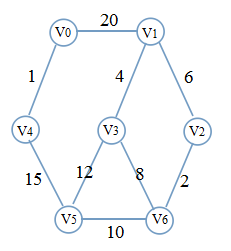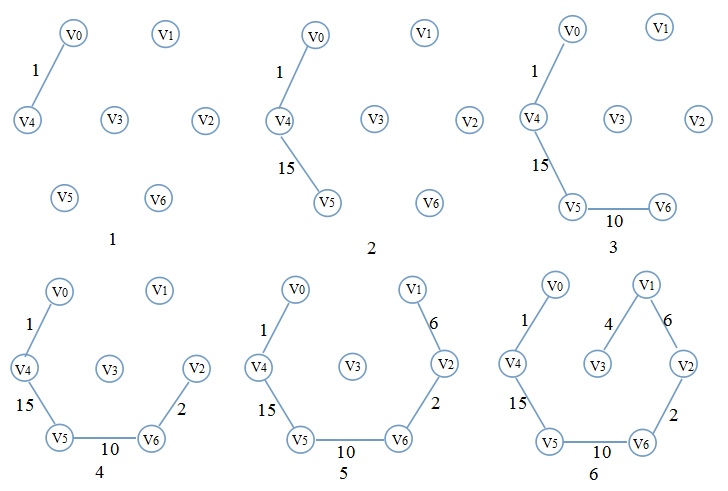最小生成树:Prim算法
最小生成树
给定一无向带权图,顶点数是n,要使图连通只需n-1条边,若这n-1条边的权值和最小,则称有这n个顶点和n-1条边构成了图的最小生成树(minimum-cost spanning tree)。
Prim算法
Prim算法是解决最小生成树的常用算法。它采取贪心策略,从指定的顶点开始寻找最小权值的邻接点。图G=<V,E>,初始时S={V0},把与V0相邻接,且边的权值最小的顶点加入到S。不断地把S中的顶点与V-S中顶点的最小权值边加入,直到所有顶点都已加入到S中。
算法说明
为了方便寻找最小权值的边,构建一最近边结构体CloseEdge:
- //最近边
- typedef struct closeedge_tag
- {
- int adjvex; //邻接点
- int weight; //权值
- }CloseEdge;
//最近边
typedef struct closeedge_tag
{
int adjvex; //邻接点
int weight; //权值
}CloseEdge;实例
从V0开始
代码
类定义
- #include<iostream>
- #include<iomanip>
- #include<stack>
- using namespace std;
- #define MAXWEIGHT 100
- //边
- typedef struct edge_tag
- {
- int tail;
- int head;
- }Edge;
- //最近边
- typedef struct closeedge_tag
- {
- int adjvex; //邻接点
- int weight; //权值
- }CloseEdge;
- class Graph
- {
- private:
- //顶点数
- int numV;
- //边数
- int numE;
- //邻接矩阵
- int **matrix;
- public:
- Graph(int numV);
- //建图
- void createGraph(int numE);
- //析构方法
- ~Graph();
- //Prim算法
- void Prim(int);
- int minEdgeVex(CloseEdge*, bool*);
- void updateCloseEdge(CloseEdge*, bool*, int);
- //打印邻接矩阵
- void printAdjacentMatrix();
- //检查输入
- bool check(int, int, int);
- };
#include<iostream>
#include<iomanip>
#include<stack>
using namespace std;
#define MAXWEIGHT 100
//边
typedef struct edge_tag
{
int tail;
int head;
}Edge;
//最近边
typedef struct closeedge_tag
{
int adjvex; //邻接点
int weight; //权值
}CloseEdge;
class Graph
{
private:
//顶点数
int numV;
//边数
int numE;
//邻接矩阵
int **matrix;
public:
Graph(int numV);
//建图
void createGraph(int numE);
//析构方法
~Graph();
//Prim算法
void Prim(int);
int minEdgeVex(CloseEdge*, bool*);
void updateCloseEdge(CloseEdge*, bool*, int);
//打印邻接矩阵
void printAdjacentMatrix();
//检查输入
bool check(int, int, int);
};类实现
- //构造函数,指定顶点数目
- Graph::Graph(int numV)
- {
- //对输入的顶点数进行检测
- while (numV <= 0)
- {
- cout << "顶点数有误!重新输入 ";
- cin >> numV;
- }
- this->numV = numV;
- //构建邻接矩阵,并初始化
- matrix = new int*[numV];
- int i, j;
- for (i = 0; i < numV; i++)
- matrix[i] = new int[numV];
- for (i = 0; i < numV; i++)
- for (j = 0; j < numV; j++)
- {
- if (i == j)
- matrix[i][i] = 0;
- else
- matrix[i][j] = MAXWEIGHT;
- }
- }
- void Graph::createGraph(int numE)
- {
- /*
- 对输入的边数做检测
- 一个numV个顶点的有向图,最多有numV*(numV - 1)条边
- */
- while (numE < 0 || numE > numV*(numV - 1))
- {
- cout << "边数有问题!重新输入 ";
- cin >> numE;
- }
- this->numE = numE;
- int tail, head, weight, i;
- i = 0;
- cout << "输入每条边的起点(弧尾)、终点(弧头)和权值" << endl;
- while (i < numE)
- {
- cin >> tail >> head >> weight;
- while (!check(tail, head, weight))
- {
- cout << "输入的边不正确!请重新输入 " << endl;
- cin >> tail >> head >> weight;
- }
- //Prim算法主要针对的是无向图
- matrix[tail][head] = weight;
- matrix[head][tail] = weight;
- i++;
- }
- }
- Graph::~Graph()
- {
- int i;
- for (i = 0; i < numV; i++)
- delete[] matrix[i];
- delete[]matrix;
- }
- /*
- Prim算法
- 求最小生成树
- */
- void Graph::Prim(int vertex)
- {
- //有numV个顶点的图的最小生成树有numV-1条边
- Edge *edges = new Edge[numV - 1];
- //标记顶点是否加入
- bool *add = new bool[numV];
- memset(add, 0, numV);
- //先把vertex加入
- add[vertex] = true;
- //最近边
- CloseEdge *closeedge = new CloseEdge[numV];
- int i;
- //初始化最近边
- for (i = 0; i < numV; i++)
- {
- closeedge[i].weight = matrix[vertex][i];
- if (!add[i] && matrix[vertex][i] > 0 && matrix[vertex][i] < MAXWEIGHT)
- closeedge[i].adjvex = vertex;
- }
- int v, count = 0;
- while (count < numV - 1)
- {
- //获取最近边的邻接点
- v = minEdgeVex(closeedge, add);
- add[v] = true;
- //把最小权值边依次加入数组edges
- edges[count].tail = closeedge[v].adjvex;
- edges[count].head = v;
- //更新最近边
- updateCloseEdge(closeedge, add, v);
- count++;
- }
- cout << "从顶点 " << vertex << " 开始,最小生成树的边是" << endl;
- for (i = 0; i < count; i++)
- cout << edges[i].tail << "---" << edges[i].head << endl;
- //释放空间
- delete[]edges;
- delete[]add;
- delete[]closeedge;
- }
- //从closeedge中寻找最小边的邻接顶点
- int Graph::minEdgeVex(CloseEdge *closeedge, bool *add)
- {
- int i, v, w;
- v = 0;
- w = MAXWEIGHT;
- for (i = 0; i < numV ; i++)
- if (!add[i] && closeedge[i].weight < w)
- {
- w = closeedge[i].weight;
- v = i;
- }
- return v;
- }
- //顶点v的加入后,需要更新最近边
- void Graph::updateCloseEdge(CloseEdge* closeedge, bool *add, int v)
- {
- int i;
- for (i = 0; i < numV; i++)
- if (!add[i] && matrix[v][i] < closeedge[i].weight)
- {
- closeedge[i].adjvex = v;
- closeedge[i].weight = matrix[v][i];
- }
- }
- //打印邻接矩阵
- void Graph::printAdjacentMatrix()
- {
- int i, j;
- cout.setf(ios::left);
- cout << setw(7) << " ";
- for (i = 0; i < numV; i++)
- cout << setw(7) << i;
- cout << endl;
- for (i = 0; i < numV; i++)
- {
- cout << setw(7) << i;
- for (j = 0; j < numV; j++)
- cout << setw(7) << matrix[i][j];
- cout << endl;
- }
- }
- bool Graph::check(int tail, int head, int weight)
- {
- if ((tail == head) || tail < 0 || tail >= numV
- || head < 0 || head >= numV
- || weight <= 0 || weight >= MAXWEIGHT)
- return false;
- return true;
- }
//构造函数,指定顶点数目
Graph::Graph(int numV)
{
//对输入的顶点数进行检测
while (numV <= 0)
{
cout << "顶点数有误!重新输入 ";
cin >> numV;
}
this->numV = numV;
//构建邻接矩阵,并初始化
matrix = new int*[numV];
int i, j;
for (i = 0; i < numV; i++)
matrix[i] = new int[numV];
for (i = 0; i < numV; i++)
for (j = 0; j < numV; j++)
{
if (i == j)
matrix[i][i] = 0;
else
matrix[i][j] = MAXWEIGHT;
}
}
void Graph::createGraph(int numE)
{
/*
对输入的边数做检测
一个numV个顶点的有向图,最多有numV*(numV - 1)条边
*/
while (numE < 0 || numE > numV*(numV - 1))
{
cout << "边数有问题!重新输入 ";
cin >> numE;
}
this->numE = numE;
int tail, head, weight, i;
i = 0;
cout << "输入每条边的起点(弧尾)、终点(弧头)和权值" << endl;
while (i < numE)
{
cin >> tail >> head >> weight;
while (!check(tail, head, weight))
{
cout << "输入的边不正确!请重新输入 " << endl;
cin >> tail >> head >> weight;
}
//Prim算法主要针对的是无向图
matrix[tail][head] = weight;
matrix[head][tail] = weight;
i++;
}
}
Graph::~Graph()
{
int i;
for (i = 0; i < numV; i++)
delete[] matrix[i];
delete[]matrix;
}
/*
Prim算法
求最小生成树
*/
void Graph::Prim(int vertex)
{
//有numV个顶点的图的最小生成树有numV-1条边
Edge *edges = new Edge[numV - 1];
//标记顶点是否加入
bool *add = new bool[numV];
memset(add, 0, numV);
//先把vertex加入
add[vertex] = true;
//最近边
CloseEdge *closeedge = new CloseEdge[numV];
int i;
//初始化最近边
for (i = 0; i < numV; i++)
{
closeedge[i].weight = matrix[vertex][i];
if (!add[i] && matrix[vertex][i] > 0 && matrix[vertex][i] < MAXWEIGHT)
closeedge[i].adjvex = vertex;
}
int v, count = 0;
while (count < numV - 1)
{
//获取最近边的邻接点
v = minEdgeVex(closeedge, add);
add[v] = true;
//把最小权值边依次加入数组edges
edges[count].tail = closeedge[v].adjvex;
edges[count].head = v;
//更新最近边
updateCloseEdge(closeedge, add, v);
count++;
}
cout << "从顶点 " << vertex << " 开始,最小生成树的边是" << endl;
for (i = 0; i < count; i++)
cout << edges[i].tail << "---" << edges[i].head << endl;
//释放空间
delete[]edges;
delete[]add;
delete[]closeedge;
}
//从closeedge中寻找最小边的邻接顶点
int Graph::minEdgeVex(CloseEdge *closeedge, bool *add)
{
int i, v, w;
v = 0;
w = MAXWEIGHT;
for (i = 0; i < numV ; i++)
if (!add[i] && closeedge[i].weight < w)
{
w = closeedge[i].weight;
v = i;
}
return v;
}
//顶点v的加入后,需要更新最近边
void Graph::updateCloseEdge(CloseEdge* closeedge, bool *add, int v)
{
int i;
for (i = 0; i < numV; i++)
if (!add[i] && matrix[v][i] < closeedge[i].weight)
{
closeedge[i].adjvex = v;
closeedge[i].weight = matrix[v][i];
}
}
//打印邻接矩阵
void Graph::printAdjacentMatrix()
{
int i, j;
cout.setf(ios::left);
cout << setw(7) << " ";
for (i = 0; i < numV; i++)
cout << setw(7) << i;
cout << endl;
for (i = 0; i < numV; i++)
{
cout << setw(7) << i;
for (j = 0; j < numV; j++)
cout << setw(7) << matrix[i][j];
cout << endl;
}
}
bool Graph::check(int tail, int head, int weight)
{
if ((tail == head) || tail < 0 || tail >= numV
|| head < 0 || head >= numV
|| weight <= 0 || weight >= MAXWEIGHT)
return false;
return true;
}- int main()
- {
- cout << "******Prim***by David***" << endl;
- int numV, numE;
- cout << "建图..." << endl;
- cout << "输入顶点数 ";
- cin >> numV;
- Graph graph(numV);
- cout << "输入边数 ";
- cin >> numE;
- graph.createGraph(numE);
- cout << endl << "Prim..." << endl;
- /*
- 由于输出结果太长,不利于截图,故只打印一半的节点
- 要想获得从所有节点开始的最小生成树,修改i的变化范围即可
- */
- for (int i = 0; i < numV / 2; i++)
- graph.Prim(i);
- system("pause");
- return 0;
- }
int main()
{
cout << "******Prim***by David***" << endl;
int numV, numE;
cout << "建图..." << endl;
cout << "输入顶点数 ";
cin >> numV;
Graph graph(numV);
cout << "输入边数 ";
cin >> numE;
graph.createGraph(numE);
cout << endl << "Prim..." << endl;
/*
由于输出结果太长,不利于截图,故只打印一半的节点
要想获得从所有节点开始的最小生成树,修改i的变化范围即可
*/
for (int i = 0; i < numV / 2; i++)
graph.Prim(i);
system("pause");
return 0;
}

完整代码下载:Prim算法
转载请注明出处,本文地址:http://blog.csdn.net/zhangxiangdavaid/article/details/38377091
若有所帮助,顶一个哦!
专栏目录:























 6512
6512

 被折叠的 条评论
为什么被折叠?
被折叠的 条评论
为什么被折叠?








